How To Correctly Measure the Efficiency of a Power Supply by PULS

September 22, 2022
Manufacturers’ data sheets often only give blanket information on efficiency and power losses of their power supplies at different mains voltages or loads. Therefore, it is advisable for users to measure the efficiency of a power supply themselves. In this blog article you will learn what you should pay attention to.
Multimeter, wattmeter, or power analyzer – which is the (measurement) tool of choice?
There are several measuring instruments which are used for the determination of efficiency. Nevertheless, the measurement tolerances and the capabilities of measuring instruments in measuring various signals (AC or DC) varies considerably.
Multimeters:
Accurate multimeters do a great job measuring the voltage and current of purely DC inputs and outputs. The voltage can be measured with high precision directly at the input and output of the power supply. Many multimeters also have built-in ability to measure current, but this is usually too inaccurate (inaccuracy of 1% or more) or it does not have sufficient measuring range (usually limited to 10A). Instead, the current should be measured by high precision shunt resistors with 0.01% tolerance. However, the non-synchronous detection of values can be problematic because it leads to errors if fluctuating conditions are present.
Watt meters:
Watt meters are used for measuring AC signals and follow the right principle. The instantaneous values of current and voltage are multiplied, and a mean value is calculated from these products – this corresponds to the physical definition of performance. However, most simple watt meters have a high measurement inaccuracy (around 1%). Moreover, frequently changing input or output currents (AC input, varying output load) cause additional measuring errors. Fluctuating values are thus difficult to interpret. Generally, only high-precision watt meters should be used when measuring efficiency.
Data loggers:
Data loggers are even better for DC measurements. They consist of a single, usually highly accurate meter, which is used several times by multiplexing. In the same measuring range, the errors even cancel off each other and all values can be promptly recorded and evaluated quickly with a spreadsheet.
Power analyzer:
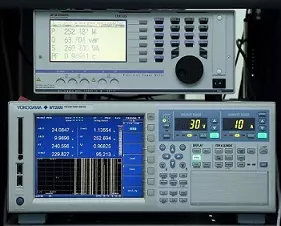
PULS uses power analyzers to measure the efficiency of its power supplies. (See image 1) The advantages of this are the high basic accuracy of 0.02%, the correct measuring of active power, the simultaneous and thus synchronous measuring of input and output, and the direct display of power losses and efficiency. The downside of this method of measuring is the high purchase price involved. Nevertheless, the power analyzer is the tool of choice for the accurate determination of efficiency.
Image 1: The efficiency of PULS’ switched-mode power supplies is measured with ultra-modern power analyzers.
Tip:
However, AC input power cannot be measured with multimeters or data loggers. It is a common mistake to assume that it is sufficient to measure the true RMS of the current and voltage and to multiply the two values to determine the input power. This calculation, however, determines the apparent power and not the real power which is crucial for the power losses. The measurement of AC input power, even with True RMS multimeters, thus gives incorrect measurements and is an absolute no-go!
Avoiding mistakes in the measurement setup
A precise and expensive power analyzer may however not provide accurate results if mistakes were made during the measurement setup.
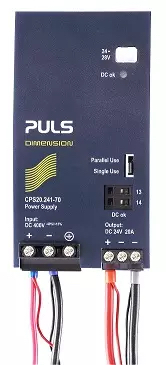
Correct wiring:
All power losses that do not come from the device under test are not allowed to be included in the measurement! This is the main principle, when it comes to correct wiring in the measurement setup. Because every cable and every contact resistance cause additional power losses that may distort the measurement results. A proper four-pole measurement (Kelvin measurement) must have separate cables for the measurement of current and voltage. (See image 2)
Voltage source:
Simple DC voltage supplies are sufficient for switch-mode power supplies with DC-input. For AC measurements, it is important to know that the internal resistance of the voltage source influences the measurement through the curve shape of the mains sine. In a 240W power supply without PFC, a difference of 0.4% was measured between the soft power from an isolating regulating transformer and the hard power from an electronic AC source. This gives the most reproducible values and is therefore preferable.
Image 2: It is decisive to do the wiring correctly. A proper four-pole measurement (Kelvin measurement) with separate cables for the measurement of current and voltage is a must.
EMC interferences:
Unshielded power supplies in the prototype stage can interfere with meters and/or can cause loads to fluctuate. You should not accept any signals with HF interference from meters. Additional filters, mostly inductors in the input lines, prevent these problems. In addition, you should not allow power losses to flow into the measurement. There should be no problems with clean, radio interference- suppressed power supplies.
Loads:
Besides the power source, the used load must also be stable and reproducible. The loads from power resistors are problematic because they do not draw a constant current. However, electronic loads represent a defined and reproducible load of the device under test and even fluctuating transition resistances do not alter the current.
Taking environmental conditions into consideration
In respect to environmental conditions, temperature plays a decisive role, because the power losses from a power supply are temperature dependent. The temperature of the components in a power supply is a crucial factor. The component temperature is the sum of ambient temperature and self-heating.
Temperature:
The various components in the power supply react differently to temperature. In some essential elements, an increase in temperature results in a reduction of power losses. But in other components the losses increase. The NTCs used for limiting the input inrush current have a strong influence. Power supplies with such components have less power losses during the startup phase and in higher ambient temperatures (negative temperature coefficient), but at higher temperatures the increase of power loss is outweighed again by other essential elements. (See diagram 2)
Devices with active input inrush current limiter show a more stable temperature behaviour. Here there is only a small increase inpower loss from temperature. For all efficiency measurements, the startup time and the ambient temperature should be documented so that the results remain traceable.
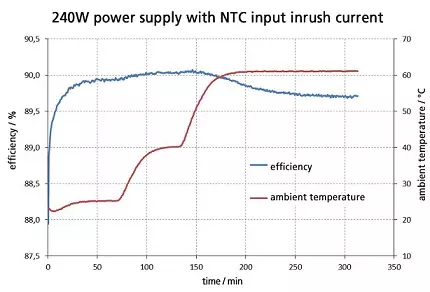
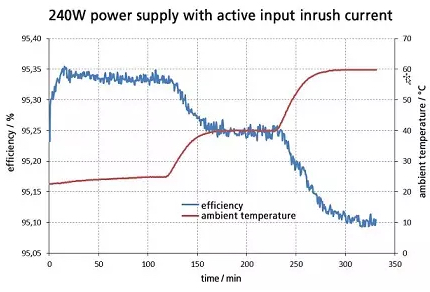
Diagram 2: Due to the NTC, efficiency is highly dependent on time and temperature
Diagram 3: The active input inrush current limiter without NTC gives an efficiency that is less time and temperature dependent.
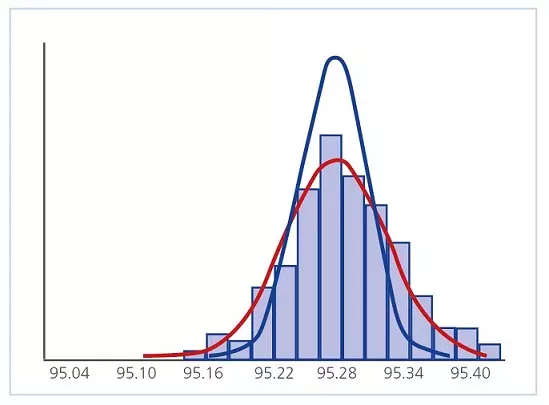
Altitude and air pressure:
Since cooling is done by air, the air pressure has an influence on self-heating. PULS has calculated how much additional heat is generated by components at a high altitude: by approx. + 10 °C at an altitude of 2,000 m above sea level and approx. + 20 °C at 4,000 m. Humidity plays only a very minor role and can be neglected.
Diagram 4: In the PULS production, an efficiency mean value of 95.27 % with a deviation of ±0.15 % was measured on a production batch of 200 devices of the type CP10
Sample distributions:
Each component has tolerances and therefore not every device is the same. But to find genuine errors, PULS measures power losses very closely even during production – although not quite as accurate as in the laboratory. A mean value of 95.27 % with a deviation of ±0.15 % was measured on a production batch of 200 devices of the type CP10 . (See diagram 4)
More information on the topic of efficiency and how it affects the efficiency of power supplies can be found here. (link)
Conclusion
The correct efficiency measurement of switched-mode power supplies is complex. But it is worth questioning the manufacturer’s data sheet information and measuring it yourself if necessary. PULS has been dealing with the exact measurement of the efficiency of its products for decades and is available to advise its customers on all questions. We have even set up our own team of experienced application engineers to provide application advice.




